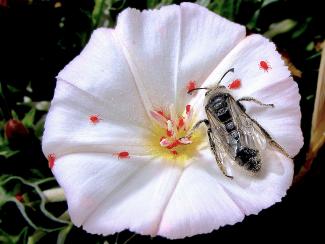
Image Credit: jacinta lluch valero
Low-antennae Dufour’s Bees (Halictidae: Rophitinae: Dufourea, Micralictoides, Conanthalictus)
These bees all share the distinctive characteristic of antennal placement very close to the mouth. All of these species would be classified as rather uncommon and as specialized-feeders. Nearly all of the native species are tiny, but several Dufourea and the 1 species of southwestern Xeralictus are mid-sized. I have always been intrigued by the host-preferences and geographic distributions of this group. Last week, July 21 2017, I finally observed my first incidence (after 50+ years) of it being parasitized by the cuckoo-bee, Neopasites.
I have since realized that many of our Northwest bee fauna are actually relatively recent immigrants across the Bearing Landbridge during the last few glaciations. All the species of Dufourea, which we originally were apparently incorrectly put together into a single phylogenetic tree, now likely represent truly southwest North American evolutionary stock mixed with several separate instances of Eurasian immigrants. For example, one subgenus of Dufourea contains specialist-feeders on bluebell (Campanula) and mariposa lily (Calochortus). They look nothing like the other native Dufourea and probably immigrated as bluebell specialists, since bluebells are a dominant resource in NW Asia. Bluebells are not abundant in the Pacific Northwest and they apparently switched preference first to the standard open-flowered mariposa-lilies and subsequently upon reaching central California to the pendant Chinese-lantern species of mariposa-lilies.

The most useful character to distinguish this generally rare group of bees is the position of the antennal attachment to the face. In nearly all bees the attachment is at or above the middle of the compound eyes, but in this Low-antenna group it is well below the mid-point. For a new student of bees, this is probably difficult to see – but after a bit of comparison it will be quite obvious. The Dufour’s-bees have a much more broadly bent basal vein for its entire distance than do typical sweat-bees.


Most members of the Dufour’s-bee subfamily are relatively small to tiny; this species on the left is one of the largest in the group of several genera. This totally melanic species, a specialist on bell-flowers (Campanula), is mentioned in the text. On the right, is the tiny bee in the genus Micralictoides; it has a weak green iridescence.